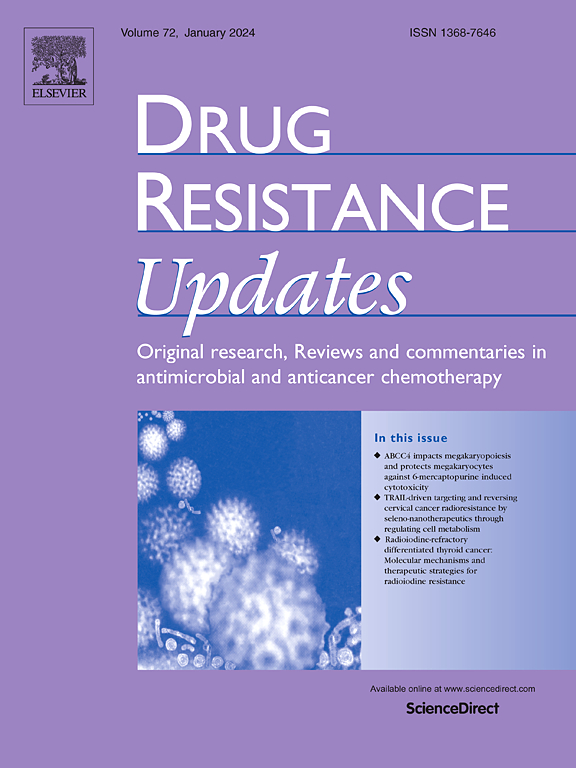外泌体衍生的lnc-FAM72D-3通过MBNL1/FAK轴重塑肝癌细胞骨架,促进lenvatinib耐药
IF 21.7
1区 医学
Q1 PHARMACOLOGY & PHARMACY
引用次数: 0
摘要
Lenvatinib耐药(LR)严重恶化了晚期肝细胞癌(HCC)患者的预后。作为细胞间通讯的关键介质,外泌体参与了LR的发展。尽管如此,外泌体衍生的长链非编码rna (lncRNAs)在这一现象中的确切作用仍未得到充分阐明。我们之前的研究发现,lnc-FAM72D-3在HCC患者的血清外泌体中明显上调,但其具体功能和潜在机制仅部分确定。在本研究中,我们建立了lenvatinib耐药HCC细胞系和类器官,并通过严格的体外和体内实验证明,外泌体衍生的lnc-FAM72D-3促进了HCC的进展,并促进了LR现象。从机制上讲,lnc-FAM72D-3增强了E3泛素连接酶het3对MBNL1的亲和力,刺激赖氨酸48连接的泛素化和随后的MBNL1降解。这种降解减少了MBNL1和focal adhesion kinase (FAK)之间的相互作用,促使FAK去核并通过磷酸化激活FAK。激活的FAK随后重组细胞骨架,显著增强HCC细胞的增殖、侵袭和干性,从而促进LR。总之,这项研究为外泌体lncRNAs在LR中的调节作用提供了新的机制见解,并提出了一种旨在减轻HCC患者LR的潜在治疗策略。本文章由计算机程序翻译,如有差异,请以英文原文为准。
Exosome-derived lnc-FAM72D-3 promotes lenvatinib resistance by remodeling hepatocellular carcinoma cytoskeleton via MBNL1/FAK axis
Lenvatinib resistance (LR) profoundly exacerbates the prognosis of patients afflicted with advanced hepatocellular carcinoma (HCC). As pivotal mediators of intercellular communication, exosomes have been implicated in the development of LR. Nonetheless, the precise contributions of exosome-derived long non-coding RNAs (lncRNAs) to this phenomenon remain inadequately elucidated. Our prior investigations identified that lnc-FAM72D-3 is markedly up-regulated in the serum exosomes of HCC patients, yet its specific functions and underlying mechanisms remain only partially defined. In this study, we established lenvatinib-resistant HCC cell lines and organoids and demonstrated, through rigorous in vitro and in vivo experiments, that exosome-derived lnc-FAM72D-3 facilitates HCC progression and contributes to the phenomenon of LR. Mechanistically, lnc-FAM72D-3 augments the affinity of the E3 ubiquitin ligase HECTD3 for MBNL1, inciting lysine 48-linked ubiquitination and subsequent degradation of MBNL1. This degradation diminishes the interaction between MBNL1 and focal adhesion kinase (FAK), precipitating the de-nucleation of FAK and its activation by phosphorylation. The activated FAK subsequently reorganizes the cytoskeleton, markedly enhancing the proliferation, invasion, and stemness of HCC cells, thereby fostering LR. In summary, this investigation offers novel mechanistic insights into the regulatory role of exosomal lncRNAs in LR and posits a potential therapeutic strategy aimed at mitigating LR in patients with HCC.
求助全文
通过发布文献求助,成功后即可免费获取论文全文。
去求助
来源期刊

Drug Resistance Updates
医学-药学
CiteScore
26.20
自引率
11.90%
发文量
32
审稿时长
29 days
期刊介绍:
Drug Resistance Updates serves as a platform for publishing original research, commentary, and expert reviews on significant advancements in drug resistance related to infectious diseases and cancer. It encompasses diverse disciplines such as molecular biology, biochemistry, cell biology, pharmacology, microbiology, preclinical therapeutics, oncology, and clinical medicine. The journal addresses both basic research and clinical aspects of drug resistance, providing insights into novel drugs and strategies to overcome resistance. Original research articles are welcomed, and review articles are authored by leaders in the field by invitation.
Articles are written by leaders in the field, in response to an invitation from the Editors, and are peer-reviewed prior to publication. Articles are clear, readable, and up-to-date, suitable for a multidisciplinary readership and include schematic diagrams and other illustrations conveying the major points of the article. The goal is to highlight recent areas of growth and put them in perspective.
*Expert reviews in clinical and basic drug resistance research in oncology and infectious disease
*Describes emerging technologies and therapies, particularly those that overcome drug resistance
*Emphasises common themes in microbial and cancer research
 求助内容:
求助内容: 应助结果提醒方式:
应助结果提醒方式:


